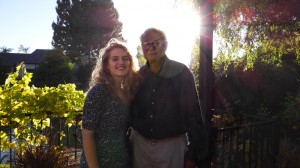Miquon ’98 meets Miquon ’42
A Miquon gathering in San Francisco in February 2012 drew alumni of all eras. Two of them, Peter Solmssen ’42 and Julia Soffa ’98, got together a few weeks later to reflect together on their experience of Miquon. Julia attended William Penn Charter School and Skidmore College after Miquon, and now works as a Product Marketing Manager for Adobe. She wrote this account of their conversation.
 Julia Soffa ’98 with Peter Solmssen ’42
Julia Soffa ’98 with Peter Solmssen ’42Eighty year-old Peter Solmssen responds to my email quickly. In fact, he responds more quickly and with more precision than most of my colleagues who work in technology. Myself included. I arrange to meet Peter at his home in Alameda, California, about a forty-minute drive across the Bay Bridge from my apartment in San Francisco. We are going to discuss our beloved Miquon School; what it meant to Peter and why schools like Miquon are important and relevant. It took us several weeks to arrange a meeting, because I had had plans, meetings, dinners, obligations; because I am 26 and I am “busy”.
The home of Peter and Kathleen Solmssen is stacked with loved artifacts, books, and collectables. Kathleen is dynamic, lovely, and holds eye contact as she unpacks a bounty from Trader Joe’s and offers me a snack.
With my iPhone cued to record the conversation, Peter invites me to sit next to him in a brown leather chair. He is prepared for our discussion, having answered the list of questions I emailed weeks before. He begins, announcing he attended Miquon “by chance”. “I came to Miquon when I was five, November 1936 with two neighbor children who rode in a Packard Limousine,” he said. Tech-savvy Peter connects his computer to his big screen TV and we watch silent Technicolor videos of children circling in costume on the wood-chipped “Upper Field”. Peter calls out the children by name, in relation to a sibling or a parent, and as the film shifts to music class, he provides an anecdote about each character. “Our lives were Miquon-centric. We were a family.” I remember the 1992 Halloween Parade in which I dressed as Catwoman, my friend Sabrina as Cleopatra and my mother Kristine in a sequin hat with an elephant on it. “It was the same for me,” I say.
“The reason that Miquon was important was not only the educational process, which I think was remarkable, but also the social context. Intelligent, interesting, sophisticated parents who built the school because they didn’t want their children to be hammered into the mold that they were hammered into”.
The Miquon community taught both Peter and myself how to operate, integrate and speak up as part of a larger group.
“What did you do after Miquon?” I ask. I learn quickly that Peter is an accomplished academic. He attended Harvard at age 16 and “spent late nights in the darkroom and did not make it to many classes.” After snapping photos of Radcliffe co-eds for the Harvard Crimson, he graduated and began working as a photographer for Life Magazine. “It was a great time to work at Life. I learned from the greats of black and white: Alfred Eisenstaedt, David Douglas Duncan, Andreas Feininger, Yale Joel and many distinguished others. ” In his humble and fluid descriptions, Peter makes it sound like he effortlessly moved on to law school at the University of Pennsylvania, to a leadership position in the Korean War, to the Diplomatic Service in Singapore and Brazil, and then to the position of President of Philadelphia’s University of the Arts. “I’ve been lucky,” he says at every turn of events. I am in awe.
Our three-hour meeting becomes a discussion of his life, my life, homage to the world view that Miquon enabled in both of us, and luck. “Miquon teaches you to be the boss,” laughs Peter. “Teaches you to see beyond the weeds, beyond the tactical”. I complain of being caught up in a profession that focuses on tasks rather than impact, on the trees rather than the forest. I liken this to an educational system focused on tests and scores rather than creativity and cultural development. If I had been educated for the purpose of taking a college entrance exam, I would have never have become emotionally invested in a fictional Wagon Train family for whom I lived and breathed in fifth grade.I had met him once before at a Miquon Bay Area alumni gathering, but I feel that I am lucky to meet Peter Solmssen, the diplomat, artist, and student for the second time in his home. I attribute our three hours together to planned serendipity, to both of us taking a chance and embracing an opportunity. It is the delicate balance between luck and embracing opportunity that distinguishes leaders…and Miquon alumni.
Peter, Kathleen, and I sit on their porch sipping meticulously prepared cocktails, discussing the Alameda antique fair, Peter’s time in Brazil, his and Kathleen’s photo exhibitions, my upcoming trips to the east coast. I have no doubt that I will see these two people again. I vow to myself that I will make room for such conversations, that I will live and breathe the big picture without letting my busy-ness get in the way.